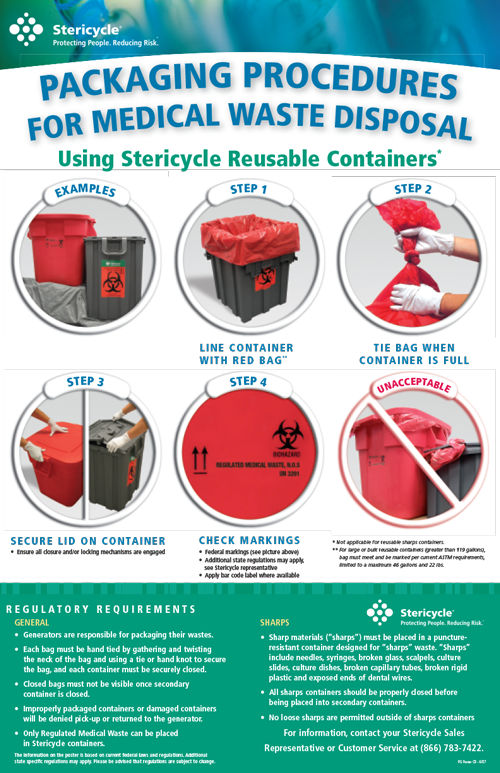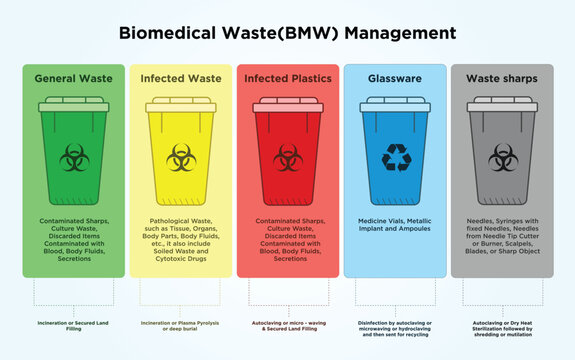Professional Medical Waste Disposal Service: Safeguarding Your Center and Area
Wiki Article
Best Practices for Medical Waste Administration
Clinical waste administration is an important aspect of health care facilities' procedures to make sure the security of patients, team, and the atmosphere. Executing best techniques in clinical waste management is essential to decrease the dangers associated with unsafe waste.Segregation and Categorization
In the field of medical waste monitoring, appropriate segregation and classification are vital practices for ensuring the secure and reliable disposal of healthcare-related products. Medical waste is produced from various resources, including health centers, centers, laboratories, and various other healthcare centers. It consists of a vast array of products, such as needles, syringes, plasters, gloves, and pharmaceutical waste.Partition involves the organized splitting up of different kinds of medical waste based upon their characteristics and prospective threats. This process assists to protect against cross-contamination and guarantees that each sort of waste is handled properly. Sharps waste, such as needles and blades, ought to be placed in puncture-resistant containers to stop injuries and the spread of infectious diseases. Likewise, transmittable waste, such as blood-soaked plasters or societies, need to be segregated and treated individually to decrease the risk of spreading pathogens.
Classification is the procedure of classifying medical waste right into various groups based upon its possible threats. WasteX Medical Waste Disposal. These groups may include infectious waste, contaminated materials, pharmaceutical waste, and general waste. By categorizing waste, medical care centers can identify the suitable disposal methods and make certain conformity with local regulations and standards
Proper partition and classification of medical waste not just secure the health and wellness of medical care workers and the basic public however also contribute to the total effectiveness and effectiveness of waste monitoring. It decreases the risk of mishaps, minimizes ecological effects, and promotes liable waste disposal techniques.
Appropriate Storage and Identifying
To ensure the secure and efficient disposal of clinical waste, healthcare facilities have to adhere to correct storage and labeling methods. Proper storage and labeling play a vital role in keeping the integrity of clinical waste monitoring systems and safeguarding the health and wellness of medical care employees, clients, and the public.When it comes to storage, it is important to have assigned locations especially developed for various kinds of clinical waste. These areas ought to be protected, well-ventilated, and outfitted with appropriate containers that meet regulative criteria. Partition and categorization of waste must additionally be taken into account to prevent cross-contamination and prospective hazards.
In addition, proper labeling is important for efficient waste administration. Each container needs to be plainly labeled with the proper signs, color-coding, and info regarding the waste it has. Tags need to consist of information such as the kind of waste, date of collection, and the name of the generator. This makes certain that all people handling the waste can easily identify and handle it correctly.
Regular monitoring and examination of storage space locations and containers are necessary to identify any problems or offenses. Team must be trained on proper storage space and labeling techniques, highlighting the value of compliance with procedures and guidelines.
Safe Transportation and Handling
Guaranteeing the correct and protected transportation and handling of clinical waste is vital for maintaining the integrity of waste monitoring systems and protecting the health and safety and security of all included. Clinical waste, which consists of items infected with contagious materials, drugs, and other unsafe compounds, must be moved in a way that prevents leaks, spills, and possible contamination.To accomplish secure transportation and handling, numerous finest techniques ought to be adhered to. First, it is necessary to utilize watertight and puncture-resistant containers that are particularly designed for medical waste. These containers ought to be effectively sealed and classified to avoid any type of accidental exposure or mishandling. In addition, waste should be segregated based on its nature and kind to stop cross-contamination.
Throughout transport, it is essential to make certain that waste containers are firmly fastened and stored in a stable manner. Automobiles utilized for transporting medical waste ought to be furnished with ideal safety and security features, such as spill containment systems, to reduce the danger of any type of spills or leakages (medical waste removal service). Chauffeurs ought to get training on appropriate handling and emergency action treatments to successfully attend to any type of unanticipated occurrences
In addition, the transport and handling of clinical waste need to abide by all pertinent guidelines and guidelines set forth by local, state, and federal authorities. Normal examinations and audits must be carried out to evaluate conformity and determine any type of areas for renovation.

Compliance With Regulatory Standards
Preserving conformity with regulative standards is important for effective clinical waste administration. These guidelines are established to safeguard public health and the setting by making certain that clinical waste is correctly handled, dealt with, and disposed of. medical waste disposal service. Compliance with governing guidelines aids to protect against the spread of contagious diseases, lessen potential threats, and minimize the overall effect of medical waste on the atmosphereTo achieve conformity, healthcare facilities must stay educated regarding the specific guidelines governing clinical waste management in their jurisdiction. These laws may differ from country to nation, and even within various states or regions. It is necessary for healthcare centers to have a comprehensive understanding of these standards and to apply suitable approaches and protocols to make sure conformity.
One key element of compliance is the appropriate partition and labeling of different types of clinical waste. This consists of separating sharps from various other waste, along with categorizing waste based upon its possible risks. Medical care facilities have to likewise ensure that medical waste is kept in ideal containers and that these containers are correctly classified and secured.
Furthermore, compliance with regulative guidelines needs medical care centers to develop appropriate training and education and learning programs for personnel included in clinical waste administration - WasteX Medical Waste Disposal. This consists of giving training on waste partition, handling, and disposal treatments, as well as the proper use why not check here of individual safety devices
Routine tracking and audits are also important to guarantee ongoing compliance with governing standards. This involves conducting regular inspections of waste storage space locations, documenting waste management treatments, and preserving records of garbage disposal.
Reliable Disposal Techniques
Health care centers must employ effective disposal approaches for correct administration of medical waste - WasteX Medical Waste Disposal. Inappropriate disposal of clinical waste can pose significant health and ecological dangers. There are several techniques that can be used to properly throw away medical waste, making certain the security of medical care workers, people, and the general publicOne generally utilized approach is incineration. Burners can securely shed clinical waste at high temperatures, lowering the volume and ruining any kind of potentially unsafe pathogens. Nonetheless, incineration can be expensive and might release dangerous pollutants into the air otherwise properly regulated.
One more approach is autoclaving, which includes subjecting the waste to high-pressure vapor. This process eliminates microorganisms, viruses, and various other microbes, making the waste secure for disposal in regular waste streams. Autoclaving is a ecologically friendly and efficient approach, however it calls for specialized devices and experienced personnel.
Chemical sanitation is additionally made use of in some cases, where fluid chemicals are used to the waste to disinfect it. This technique is much less generally used because of worries concerning the effectiveness of chemical sanitation and the capacity for chemical deposits to infect the environment.
In addition to these techniques, health care centers need to additionally implement appropriate segregation, product packaging, and labeling of clinical waste to guarantee its secure handling and disposal. Normal training and education and learning of staff on proper waste management practices are vital to keeping reliable disposal approaches.
Verdict

Medical waste monitoring is a critical facet of health care facilities' procedures to guarantee the safety of people, personnel, and the environment. Carrying out finest techniques in medical waste management is necessary to reduce the threats connected with hazardous waste. These groups may consist of contagious waste, unsafe waste, pharmaceutical waste, and general waste.In conclusion, carrying out best methods for medical waste monitoring is vital for guaranteeing the safety and security of health care employees, individuals, and the environment. By effectively categorizing and setting apart waste, saving and identifying it appropriately, ensuring secure transportation and handling, conforming with governing guidelines, and using effective disposal techniques, medical care facilities can successfully take care of and reduce the threats associated with medical waste.
Report this wiki page